UNDERSTANDING OUR DHARMA OR PURPOSE
This brings us to the purpose of our dharma and our incarnation, which are part of the impulse of God to begin to see the harmony of life. We begin by understanding that the three gunas[1] (tamasic, rajasic, sattvic) correspond with the Individual ego (lower), Universal ego, and Divine impulse or inclination. The lower ego will bring suffering, which is tamasic. No matter what activity we undertake in thought, word, or deed while in the lower ego, it will end with incompleteness and will therefore bring suffering. The Universal ego is rajasic; it is activity. The rajasic activity of the Universal will or ego will be influenced by our intent. What is our intent? Do we want the activity to be selfless and for the benefit of others? This would be sattvic. Do we want the activity to be a harvest for our own benefit? With this, we have added either a sattvic or a tamasic intent to the Universal will. This is why some people can flourish while others, doing the same activity with seemingly the same motives, hardly get anywhere. One has the intent of giving unconditionally, and the other has the intent of partaking in the harvest.
The sattvic guna (vibration) is part of the Divine Will or impulse. It is identified with Satyam, Shivam, Sundaram, and is beyond any thought of individual identity. It is part of the one God, part of the Christ/Krishna Consciousness, part of the Holy Stream. Once we go beyond the Individual ego, and move into the universal ego, we can then surrender to the Divine Will or impulse.
We need to have a working understanding of these three stages of the Divine impulse. Then we need to understand that each chakra is seeking fulfillment, and is calling out for completion. At the first chakra, we want to survive, learn, grow, and mature. Whether we want liberation, or Self-realization, or just happiness, the Soul will call out for more. The Soul calls out for the completion of the Divine impulse. The Soul will call out for completion of all seven levels, or at each chakra.
The first chakra will want food, rest, self-preservation, and procreation. We can channel it in a more harmonious way by having more prana as nutrition, more meditation to be in harmony with our nature. Instead of sleep, we have rest and feel peaceful. Instead of the procreation desire, we can be more creative within the Divine Will. For the self-preservation instinct, we realize that we are infinite and eternal.
At the second chakra where we are looking for completion in the male/female relationship and for children, instead we can balance the ida and pingala, and allow the sushumna to be the offspring running up to the Christ/Krishna Consciousness, and allowing the kundalini to awaken. When we inwardly find the balance of the ida and pingala, we will no longer feel the pull to have the completion take place externally with the sexual relations of the male/female. Rather we will find a creative expression to fulfill our dharma, whether we choose to be a host to children or not.
At the third chakra, the desire for human affection and connection, and the desire to fit in with humanity will, with meditation, transform into a desire to fulfill our Divine purpose, or dharma. We will begin to feel like we are connected to humanity. We will feel like we have a role or purpose within the Cosmic Consciousness. We will feel the pull of our Soul with God.
At the fourth chakra we have unconditional Love. We begin to live in a state of Om Satyam, Om Shivam, Om Sundaram. We now begin to give to life, give to God, give to humanity, give to the planet, give to the angels and devas. No matter who we encounter, we will want to be constantly feeling Om Satyam. That is what we are trying to vibrate out and identifying with. No matter what we come into contact with, whether the minerals, animals, plants, humans, angels or devas, they will benefit from the Om Satyam joy of love, harmony, and beauty that we are vibrating.
At the fifth chakra, we are now willfully vibrating the Om Satyam. We are willfully manifesting and beginning to create more Satyam, Shivam, Sundaram. Instead of just identifying with and vibrating Divine love, we are beginning to willfully channel and manifest more of the Om Satyam. We are beginning to influence those who think of, or come in contact with us. We are beginning to influence those that our vibration reaches or touches. The power of our vibration will reach out to be inclusive of all we are aware of.
At the sixth chakra, we continue to expand beyond the Universal will to the Christ/Krishna Consciousness. We are now in union with God. We are from God, of God, and part of God. We are now becoming the Divine Will. We begin to create more and more Satyam, Shivam, Sundaram.
We have become what is referred to as a Realized Soul, or an Enlightened Being. When this Realized Soul attains liberation and leaves the body, and then comes back out of the formless and takes an incarnation, they are given the title of Avatar. This Avatar, or Divine Light that incarnates back, takes on original sin and ideas and samskaras, which they will have to work off. Still there will be a part of their consciousness that is in a constant state of union with the Christ/Krishna Consciousness. They will constantly be emitting the vibration of Satyam, Shivam, Sundaram. When you read the ancient scriptures, you will find stories of someone who walked into the presence of a young child, not knowing who they were, and they were uplifted and healed because the Divine Light was so strongly vibrating out of the child. This is the state we strive to attain. I don’t necessarily mean attaining the state of being an Avatar and healing people, but to the state of realization of the Christ/Krishna Consciousness, the state of being in union with God. This is the state of Oneness, the dance of the Soul with absolute God Consciousness. We will be vibrating Satyam and continuously giving it to life at all levels. This is the Soul calling out for more, and experiencing its completion.
[1] Gunas: Triune qualities of nature, those being sattvic (positive), rajasic (active), tamasic (negative).


